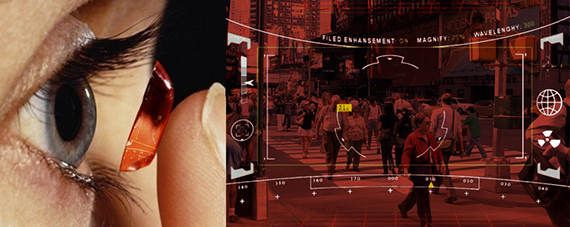As we all know from generations of reliable Hollywood movies, the ability to see infrared spectrums of light has foiled many an evil plot for many a super-secret spy. But in today’s world of Google Glass, GoPros and other such technology, infrared googles suddenly seem cumbersome and obsolete—shouldn’t there be something that lets us super-secret spy folk see through walls with just a blink?
Well, since you asked, researchers at the University of Michigan might have come up with a little something:

DUDE.
The team of researchers used something called graphene to create a pinky-nail sized infrared sensor, a substance that allows its wearers to access and see infrared wavelengths. It’s a material that’s comprised of only a single layer of carbon atoms, and can detect the whole of the infrared light spectrum, as well as ultraviolet light and our own boring visual spectrum.
Sounds perfect for an infrared sensor, begging the question of why it’s never been used before. Sadly, while graphene is capable of detecting all of those wavelengths of light, the fact that it’s only one atom thick means that it can only absorb 2.3% of the light that hits it—not enough for an electric signal to be generated for a sensor. Until Michigan’s team got around it.
Rather than measuring the electrons released when light strikes graphene, the team amplified an electrical current near the electric signals generated by that incoming light, by sandwiching an insulator in between two sheets of the material. They achieved a quantum tunneling effect through that layer, by running an electrical current through the bottom graphene sheet. When light hit the top sheet, the electrons were freed, generating positively charged electron holes and subsequently, the quantum tunneling effect.

Using this technology, the team has been able to develop infrared sensors the size of a pinky nail…or a contact lens. While they have not created actual contacts yet, the team is hopeful about the applications of their innovation, which range from medical—allowing doctors to actually see blood flow; cool but creepy—or letting soldiers see in the dark, or, you know, super-spy stuff.
“If we integrate it with a contact lens or other wearable electronics, it expands your vision,” said Michigan assistant professor Zhaohui Zhong in a press release. “It provides you another way of interacting with your environment.”
Still, we’re probably more than a few years away from seeing contacts that actually allow commercial users to have superhero infrared vision. But just knowing the possibility exists is kind of exciting, don’t you think?
Source Discovery
Advertisement
Learn more about Electronic Products Magazine






